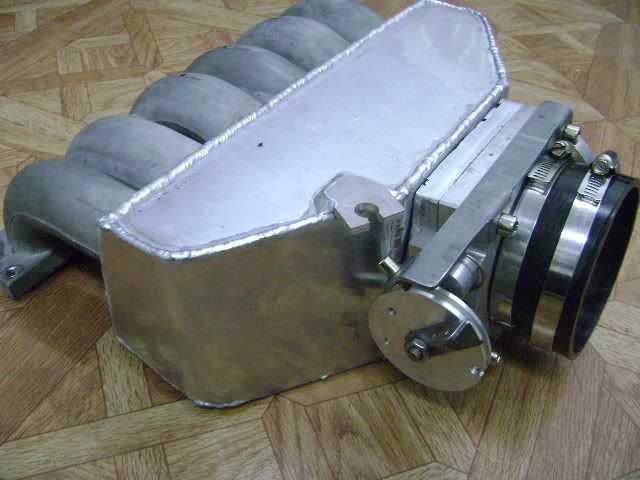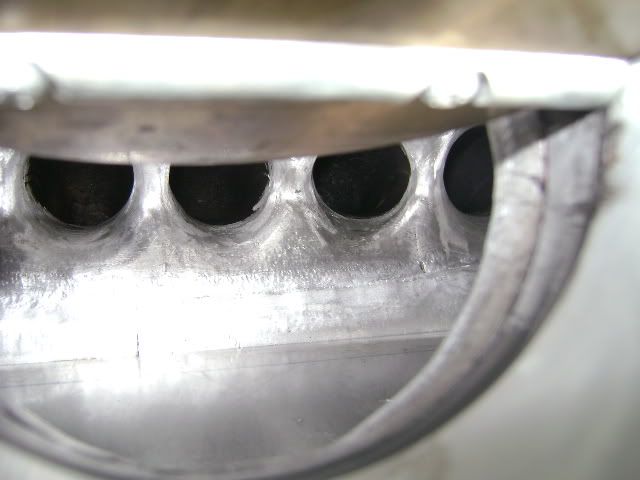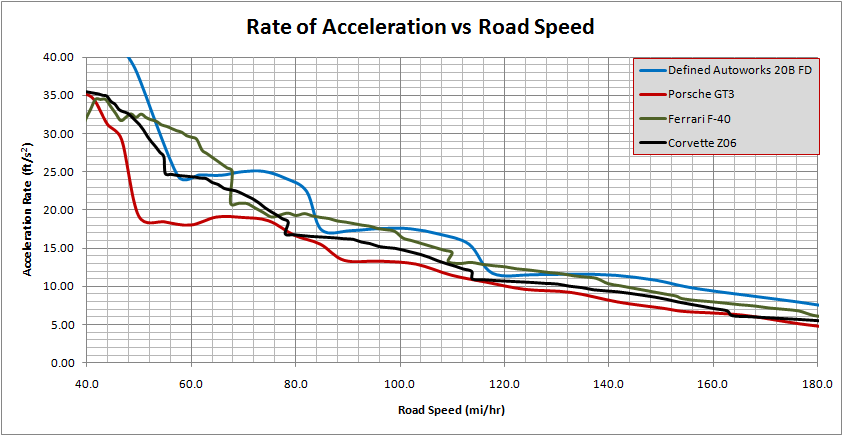Non-turbo 428rwhp FD build up and history
#101
Wow, these charts are even better than I expected! Very exciting to see. Seth (shm21284) is a very skilled engineer so its nice to have his talent on tap for projects requiring this type of knowledge. Excellent job buddy  I have to admit I was really a bit nervous to see the results going against the c6 z06 and F40. Real eye opener for sure.
I have to admit I was really a bit nervous to see the results going against the c6 z06 and F40. Real eye opener for sure.
 I have to admit I was really a bit nervous to see the results going against the c6 z06 and F40. Real eye opener for sure.
I have to admit I was really a bit nervous to see the results going against the c6 z06 and F40. Real eye opener for sure.
#102
This is the kind of good, sound, scientific data we need to analyze the differences between rotary designs and other benchmark cars. I don't know what the whp of the GT3 was assumed to be.
I'd love to see the same analyses for a 425 whp turbo and a 300 hp 20b NA. I would be fascinated to see how close the rate of acceleration is to the GT3.
Great stuff, Logan and thanks, Mystery Motor Science Guy!
Gordon
I'd love to see the same analyses for a 425 whp turbo and a 300 hp 20b NA. I would be fascinated to see how close the rate of acceleration is to the GT3.
Great stuff, Logan and thanks, Mystery Motor Science Guy!
Gordon
 Oh yeah, the GT3 is 375rwhp, its dyno chart is plotted out on the last graph for easy reference.
Oh yeah, the GT3 is 375rwhp, its dyno chart is plotted out on the last graph for easy reference.
Last edited by GtoRx7.; 01-28-11 at 01:09 AM.
#103
If I'm reading the charts correctly, it would appear that the 20b is maintaining a higher more consistent levels of acceleration for a longer period of time? With the other cars, it seems they are loosing trust after each gear change, not so with he 20b.  The funny thing is, those numbers would look even better with a closer ratio Rx8 style 6 speed.
The funny thing is, those numbers would look even better with a closer ratio Rx8 style 6 speed.
 The funny thing is, those numbers would look even better with a closer ratio Rx8 style 6 speed.
The funny thing is, those numbers would look even better with a closer ratio Rx8 style 6 speed.
#104
#105
Thank you so much Seth!
All this "torque" talk is just that- talk.
Gears for the win!
Would you share your charts so we can all input our various cars and or dream cars?
Or make this awesome tool available to us by some other means?
All this "torque" talk is just that- talk.
Gears for the win!
Would you share your charts so we can all input our various cars and or dream cars?
Or make this awesome tool available to us by some other means?
#106
Thanks, guys.
Looks like a transposed the colors on the last graph for the Ferrari and the Corvette.
It should be noted that the aerodynamic information that we can find is not as accurate at higher vehicle speeds due to increased pressure drag from higher amounts of turbulent separation in the wake of the vehicle. Cd is really a function of velocity rather than simply a set value.
Looks like a transposed the colors on the last graph for the Ferrari and the Corvette.
It should be noted that the aerodynamic information that we can find is not as accurate at higher vehicle speeds due to increased pressure drag from higher amounts of turbulent separation in the wake of the vehicle. Cd is really a function of velocity rather than simply a set value.
#107
I guess we have to keep in mind that the charts do not take into account limit of traction at the tires nor the effect of wheel/tire/driveline mass/inertia on rate of acceleration.
That would really even out the low speed 1st gear acceleration between cars of similar traction levels (note- Porshe has rear weight bias as an advantage).
The rotating inertia is going to be related directly to the traction issue- if you try to go skinny on wheel/tires for less inertia to accelerate your lower speed/gear acceleration will suffer from lack of traction. This could be a chart unto itself.
That would really even out the low speed 1st gear acceleration between cars of similar traction levels (note- Porshe has rear weight bias as an advantage).
The rotating inertia is going to be related directly to the traction issue- if you try to go skinny on wheel/tires for less inertia to accelerate your lower speed/gear acceleration will suffer from lack of traction. This could be a chart unto itself.
#108
If I'm reading the charts correctly, it would appear that the 20b is maintaining a higher more consistent levels of acceleration for a longer period of time? With the other cars, it seems they are loosing trust after each gear change, not so with he 20b.  The funny thing is, those numbers would look even better with a closer ratio Rx8 style 6 speed.
The funny thing is, those numbers would look even better with a closer ratio Rx8 style 6 speed.
 The funny thing is, those numbers would look even better with a closer ratio Rx8 style 6 speed.
The funny thing is, those numbers would look even better with a closer ratio Rx8 style 6 speed.
#109
I guess we have to keep in mind that the charts do not take into account limit of traction at the tires nor the effect of wheel/tire/driveline mass/inertia on rate of acceleration.
That would really even out the low speed 1st gear acceleration between cars of similar traction levels (note- Porshe has rear weight bias as an advantage).
The rotating inertia is going to be related directly to the traction issue- if you try to go skinny on wheel/tires for less inertia to accelerate your lower speed/gear acceleration will suffer from lack of traction. This could be a chart unto itself.
That would really even out the low speed 1st gear acceleration between cars of similar traction levels (note- Porshe has rear weight bias as an advantage).
The rotating inertia is going to be related directly to the traction issue- if you try to go skinny on wheel/tires for less inertia to accelerate your lower speed/gear acceleration will suffer from lack of traction. This could be a chart unto itself.
#110

#111
All out Track Freak!
iTrader: (263)
Joined: Jul 2001
Posts: 10,672
Likes: 412
From: Charlottesville VA 22901
Great example of why loosing weight is so important. Even if it's just 100lbs it will make a tremendous difference at speed over a given lap as you accelerate, brake and corner many times in that one lap. It will start to add up to a lot of gained time.
Strip that vette down to 2800lbs or the even the GT3 and look out.
Strip that vette down to 2800lbs or the even the GT3 and look out.
#114
It should be mentioned driveline weight also has an exponential effect on centripetal acceleration at higher velocities/engine speeds. Double bonus.
#116
Great example of why loosing weight is so important. Even if it's just 100lbs it will make a tremendous difference at speed over a given lap as you accelerate, brake and corner many times in that one lap. It will start to add up to a lot of gained time.
Strip that vette down to 2800lbs or the even the GT3 and look out.
Strip that vette down to 2800lbs or the even the GT3 and look out.
 A few reasons- 1) It was free 2) I wanted to see if I could accomplish a race look with race function while staying factory. 3) Its a hunch but I think it provides less drag than aftermarket "large" openings, with a better inlet/ exit ratio.
A few reasons- 1) It was free 2) I wanted to see if I could accomplish a race look with race function while staying factory. 3) Its a hunch but I think it provides less drag than aftermarket "large" openings, with a better inlet/ exit ratio. So far its amazing for cooling. I can sustain hard 10k rpm use for a while and not budge the temps past 190 degrees. But more testing in 95+ degree weather will prove for sure!
#117
What year Rx-8? '04 or '09? The ratios (according to rx8club.com) are:
Car (1st 2nd 3rd 4th 5th 6th FD)
04-'08' RX-8 (3.760 - 2.269 - 1.645 - 1.187 - 1.000 - 0.843 - 4.440)
09' RX-8 R3 (3.815 - 2.260 - 1.640 - 1.177 - 1.000 - 0.832 - 4.770)
Honestly, I could do both, but is there a preference?
Car (1st 2nd 3rd 4th 5th 6th FD)
04-'08' RX-8 (3.760 - 2.269 - 1.645 - 1.187 - 1.000 - 0.843 - 4.440)
09' RX-8 R3 (3.815 - 2.260 - 1.640 - 1.177 - 1.000 - 0.832 - 4.770)
Honestly, I could do both, but is there a preference?
#119
A car's weight affects it's acceleration equally at any velocity in any direction. Drag happens to be a much larger force in resistance to forward motion. But, that doesn't diminish the effects of weight.
It should be mentioned driveline weight also has an exponential effect on centripetal acceleration at higher velocities/engine speeds. Double bonus.
It should be mentioned driveline weight also has an exponential effect on centripetal acceleration at higher velocities/engine speeds. Double bonus.
#122
Thanks, nice sig picture! So to sum up the technical graphs, I think its obvious here that when done properly, a small naturally aspirated 20b can put some of the BEST factory powerplants through their paces and win. 

#124
I had a lot of requests to post more pics of the sheet metal intake manifold, but I lost the pics. Recently was able to find the old memory card, so here it is. This setup uses a 90mm throttle body. All the port entrances are fully venturied for optimal flow. We manufacture and sell this part for anyone interested. Its a half-way step between the stock intake and Gordons fully custom tapered runner design.
Price is $1100.00




Price is $1100.00




#125
4th string e-armchair QB
iTrader: (11)
Joined: May 2005
Posts: 2,745
Likes: 0
From: North Bay, Ontario
My mind just exploded.  Nice to see all your info in one thread. This is officially my dream track-car! Maybe a little nitrous for the streets for that angry barbaric power lust though...
Nice to see all your info in one thread. This is officially my dream track-car! Maybe a little nitrous for the streets for that angry barbaric power lust though... 
I'm surprised you haven't tried port-phased rotors yet, I thought those were CLR's specialty? Surely that can gain you something without affecting idle/drivability too much, it does seem like you've found the mechanical limit for your current setup minus the variable length intake runners you mentioned. Either that or adding bridge ports, I know some drag racers on the giggly gas were fond of that setup, low end will suffer though.
You mentioned trying to eliminate the air gap between the semi-pp TB and port opening. This has been on my mind for a long time, as I'd like to someday build a semi-pp 13B with staged throttle. The only things I could come up with are a slide throttle body setup nearer the port face, or some reed valves. Although I'm not sure I'd be comfortable having some delicate reeds sitting near the port face waiting to be ingested! Any hints you wanna share?

I'm surprised you haven't tried port-phased rotors yet, I thought those were CLR's specialty? Surely that can gain you something without affecting idle/drivability too much, it does seem like you've found the mechanical limit for your current setup minus the variable length intake runners you mentioned. Either that or adding bridge ports, I know some drag racers on the giggly gas were fond of that setup, low end will suffer though.
You mentioned trying to eliminate the air gap between the semi-pp TB and port opening. This has been on my mind for a long time, as I'd like to someday build a semi-pp 13B with staged throttle. The only things I could come up with are a slide throttle body setup nearer the port face, or some reed valves. Although I'm not sure I'd be comfortable having some delicate reeds sitting near the port face waiting to be ingested! Any hints you wanna share?









